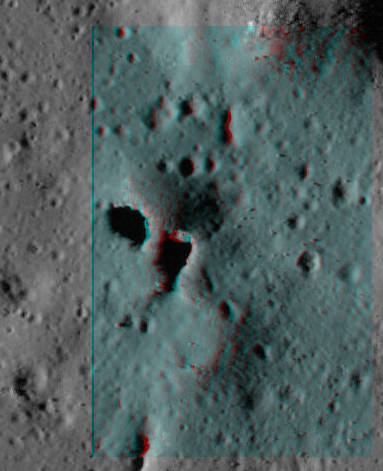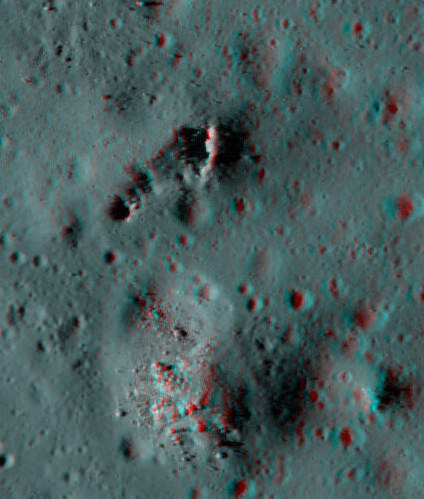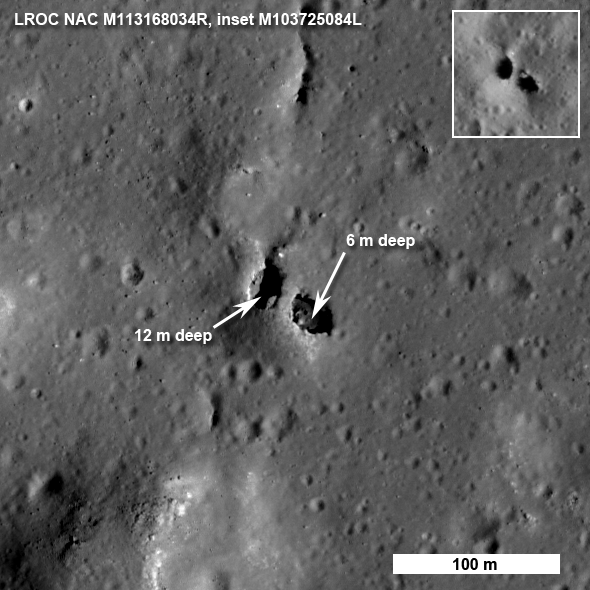[/caption]
“Just when you think you have seen everything, LROC reveals a natural bridge on the Moon!” said Mark Robinson, Principal Investigator of the Lunar Reconnaissance Orbiter Camera (LROC), writing on the LROC website. “Who would have thought?” The natural bridge seen in this image is about 7 meters (23 feet) wide on top and perhaps 9 meters (30 feet) on the bottom side. Scientists estimate it would be a 20-meter (66-foot) walk to cross from one side to the other. While there are natural bridges here on Earth (which usually form as a result of wind and water erosion — see here for images of a natural bridge in Virginia in the US) how would such a natural structure form on the Moon? The answer might include another intriguing feature that has been found recently on the Moon: lava tubes.

Robinson said the most likely way this feature formed is from a dual collapse into a lava tube. These are deep holes on the Moon that could open into vast underground tunnels, and could serve as a safe, radiation shielding habitats for future human lunar explorers.
There are actually a couple of these natural bridges that were found in just one region on the Moon, in the midst of an impact melt in the 15 km-wide King crater. Nathanial Burton-Bradford has created a few stereo images, which provide a unique perspective on these lunar bridges. Nathanial called the one below a “strange ‘twiglet’ ‘Monster Munch’ shape bridge.”

How can the lunar scientists be certain this feature really is bridge over a cavern? Look closely at the top image and in the pit on the west or left side, there is a small crescent of light on its floor. That patch of light came from the east, under the bridge.
Although Robinson and his team do not know for certain the details of how the bridge formed, here’s one possible scenario: The impact melt that was thrown out of the crater pooled on the newly deposited ejecta and must be many tens of meters thick, allowing its interior to stay molten for a long time. As the local terrain readjusted after the shock of the impact, the substrate of this massive pool of melt was jostled to some degree. Local pressures built up and the melt moved around under a deforming crust. You can see that the south end of the bridge extends from a small local rise, shaped something like a blister. Perhaps some melt was locally pushed up forming the rise, then the magma found a path to flow away, leaving a void which the crusted roof partially collapsed.
The LROC team is working on making their own stereo images, but in the meantime, thanks to Nathanial Burton-Bradford for providing us with a preview!
See more on the LROC website, and at Nathanial’s Flickr page.


This is WAS double extre groovy cool! I really, really like the idea of finding possible habitat(s) on Luna! Lets go!
You did not mention the location of King Crater.. it’s on the far side near 120°E, 5.5°N I’d like to nominate this area for a possible radio telescope, there are a couple smaller circular craters there that might work for that! Check out this ‘flyover’ animation?
http://www.lpi.usra.edu/lunar/lunar_flyovers/king_crater/
Ooops… is WAY double extre….
Do you have Twiglets and Monster Munch in the US?
Is it too much to ask for LRO to get a picture of the troll under the bridge?
hi, carbon copies 😉
anybody who can tell if we are radar mapping the lunar underground?? Wouldn’t that be a logical thing to do… Anyway, i always believed (still do) that our moon would be the perfect base for exploration of the solar system , given the fact that raw materials are present in abundance.
With the discovery of water molecules on the moon it looks like there is a bridge over troubled water — ok I hear the groans.
LC
Aqua, you are right. The King crater flyover is really cool! The only thing missing are FOOT PRINTS! Obamavich is an asswipe…..